Golioth returned to Embedded World in 2023 to showcase at the Zephyr booth. We brought a range of designs built with Zephyr and connected to the Golioth Cloud. Each of our Reference Designs show how Golioth technology can target verticals throughout the industry. We are regularly creating new designs and posting about them, both on this blog and on the Golioth Projects site.
Moving To Common Elements With Our 2023 Designs
We had a more standardized form factor and design elements with our 2023 designs than our demos at Embedded World 2022. Last year, we wanted to differentiate the functions and features of the Golioth Cloud when showcasing the “color demos”. Each of these demonstrated the different parts of our platform.
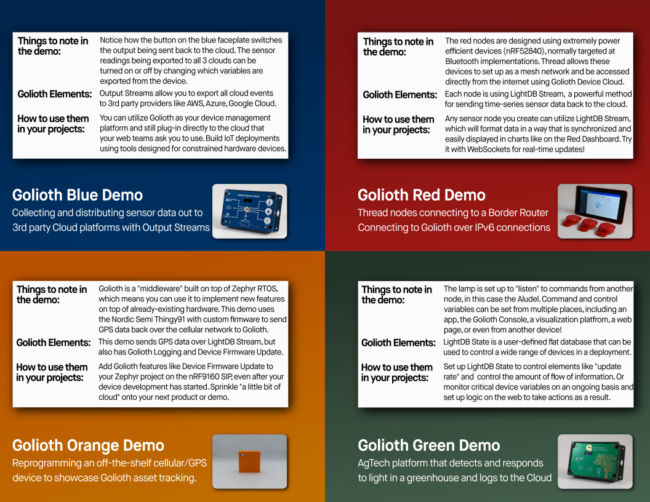
This year was all about showcasing how similar many IoT designs can be. By extension, we wanted to show how we can swap some hardware and firmware to target entirely different market segments.
We built a new form factor that contains off-the-shelf hardware but still presents it in a somewhat compact manner. This took the form of the Aludel Mini case and PCB design, as well as our Ostentus front panel, both of which we have written about before. The result is a black box (har har) that allows us to target verticals. Our goals in the near future is to create additional firmware resources to make it easier for our users to replicate these designs using 100% off-the-shelf components.
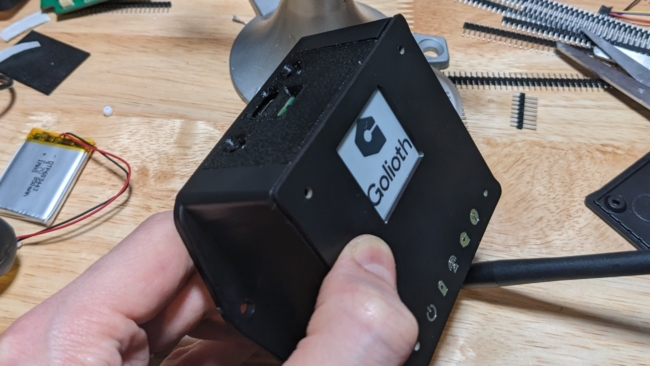
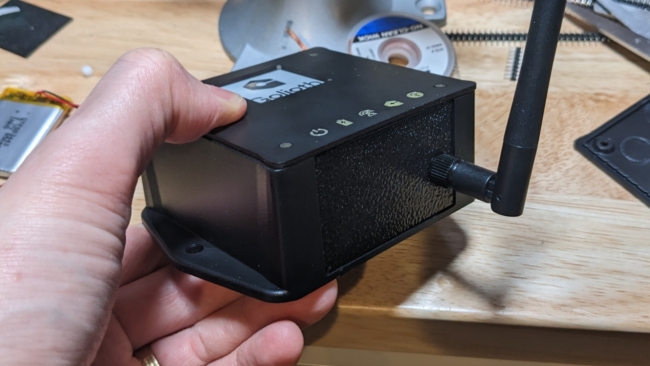
The 2022 designs had explanatory information / diagrams on the top PCB. This year we migrated to putting that information on a laser cut backing plate used as a mounting surface for the actual Reference Designs. These allowed visitors to read more on their own, if they desired, and kept our Reference Designs smaller and more like what might be deployed to the field. See images below for examples of backing plates.
Reference Design Demos
We brought 5 Reference Designs with us to Embedded World. In fact, we had more demos than we had space in the Zephyr booth to showcase them! Alas, we tried our best to highlight each element to the people walking by our booth.
DC Power monitor
This design was based off of our AC Power Monitor Reference Design that we have published about before. However, when thinking about logistics at a conference, we didn’t feel comfortable monitoring AC power in the booth. Instead, Mike took the design and swapped out the Click headers and reworked some of the firmware to instead monitor USB power flowing through the design. In the video above, you can see that we monitored the current of a fan and a USB lightbulb and then were able to dynamically chart the power usage on our bespoke Grafana dashboard.
Air Quality Monitor
Our Air Quality Monitor Reference Design was so new for Embedded World that we had only just published about it on our projects site. We will be doing a blog post and video about it soon. The main focus was capturing and displaying this information both on the Ostentus display (front panel) and then on the associated dashboard.
There are two interesting things that differentiate this design from the others. The first is a Remote Procedure Call (RPC) that directly activates the fan onboard to start a cleaning cycle. This is a great example of how RPCs can be used for one-off activities triggered programmatically on an “as needed” basis.
The second is the use of LightDB State to visualize and trigger warnings from the device. Note the red dotted line in the chart on the CO2 concentration. This is a configurable level in LightDB State on a per-device basis. It could be used to trigger a local alarm (light, sound) or can be used to trigger other notification/alarm activities on the cloud.
Cold Storage Asset Tracker
Last year we brought an asset tracker in the form of the Orange Demo, based upon the Nordic Thingy91. This year we upgraded with a more accurate tracking GPS module that can run simultaneously with the cellular modem.
The unit tracks temperature for “cold storage” applications. This is a common use case for refrigerated trucks and shipping containers, as wells as tracking of vaccines in transit between medical facilities. Demonstrate GPS inside a conference hall is a challenge because of being locked to one position and under a bunch of metal girders, but we were able to showcase the underlying hardware and example paths that recalled historic trip data stored on Golioth.
IoT Trashcan Monitor
Our waste management solution is made to help municipalities and parks departments more efficiently route their diesel trash trucks. As in the rest of our demos, this becomes and exercise in scaling things down to fit on a tabletop in a conference facility. We achieved this by creating a portable (foldable) trashcan that we can setup on conference booth tables.
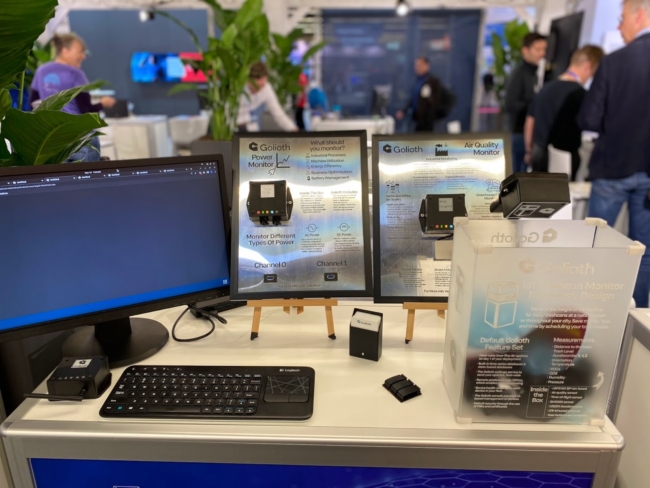
The miniature version of a trashcan helps to illustrate the usefulness of the Golioth Settings Service. The original demo had a trashcan that was roughly 1 meter tall and all of the “percentage-full” levels were based off of that height. Golioth makes it simple to select the individual device we brought to the show and adjust the height for a 300 mm tall trashcan. This “calibration” was instantly sent down to the device and it reported levels in exactly the same way it had for a taller trashcan.
Soil Moisture Monitor
The Soil Moisture Monitor Reference Design measures soil moisture levels and the amount of light reaching the unit. During this conference it barely saw any light, since we ran out of room on the desk! You can find full details in the soil moisture monitor demo video, and project page. We will have this and many new designs on display at the Embedded Open Source Summit in Prague in late June. Please be sure to stop by there to see what we have been working on!
We’ll Train You To Build Your Own Zephyr Design
One of the things we were sure to point out in each of the example videos above is that we are running new training sessions showing people how to design with Zephyr. If you’d like to learn how to build your next design with the popular Open Source RTOS and Ecosystem, sign up at golioth.io/ew23.

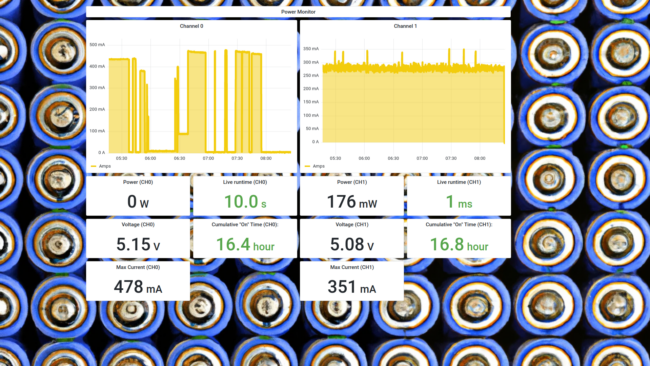
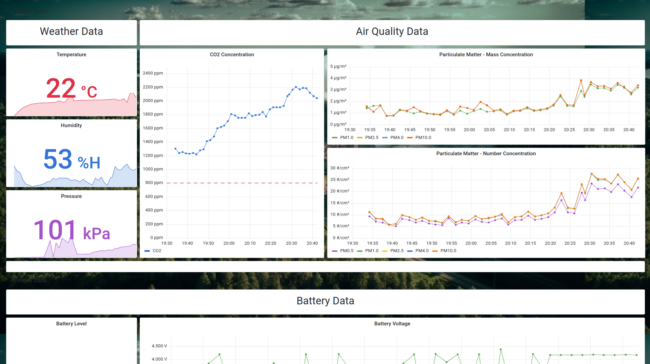
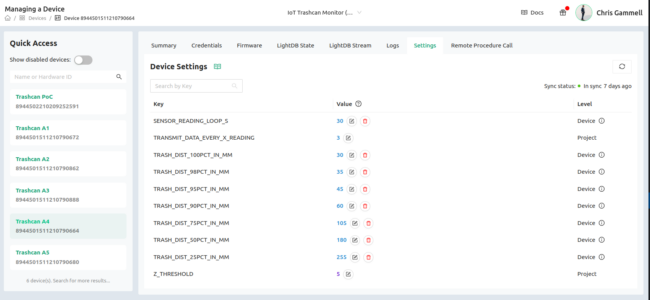

No comments yet! Start the discussion at forum.golioth.io